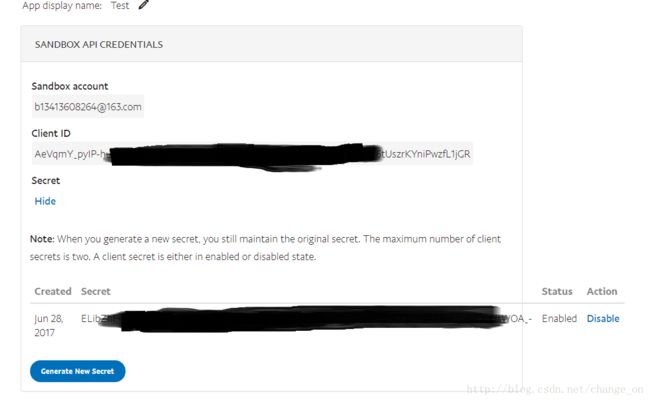最详细的 paypal 支付接口开发--Java版
做全球性的支付,选用paypal!为什么选择paypal? 因为paypal是目前全球最大的在线支付工具,就像国内的支付宝一样,是一个基于买卖双方的第三方平台。买家只需知道你的paypal账号,即可在线直接把钱汇入你的账户,即时到账,简单方便快捷。
在集成paypal支付接口之前,首先要有一系列的准备,开发者账号啊、sdk、测试环境等等先要有,然后再码代码。集成的步骤如下:
一、环境准备
注册paypal账号
注册paypal开发者账号
创建两个测试用户
创建应用,生成用于测试的clientID 和 密钥
二、代码集成
springboot环境
pom引进paypal-sdk的jar包
码代码
测试
后言
现在开始
- 注册paypal账号
(1)在浏览器输入“https://www.paypal.com” 跳转到如下界面,点击右上角的注册
(2)选择,”创建商家用户”,根据要求填写信息,一分钟的事,注册完得去邮箱激活
- 注册paypal开发者账号
(1)在浏览器输入“https://developer.paypal.com”,点击右上角的“Log into Dashboard”,用上一步创建好的账号登录
- 创建两个测试用户
(1)登录成功后,在左边的导航栏中点击 Sandbox 下的 Accounts
(2)进入Acccouts界面后,可以看到系统有两个已经生成好的测试账号,但是我们不要用系统给的测试账号,很卡的,自己创建两个
(3)点击右上角的“Create Account”,创建测试用户
<1> 先创建一个“ PERSONAL”类型的用户,国家一定要选“China”,账户余额自己填写
<2> 接着创建一个“BUSINESS”类型的用户,国家一定要选“China”,账户余额自己填写
<3>创建好之后可以点击测试账号下的”Profile“,可以查看信息,如果没加载出来,刷新
<4>用测试账号登录测试网站查看,注意!这跟paypal官网不同!不是同一个地址,在浏览器输入:https://www.sandbox.paypal.com 在这里登陆测试账户
- 创建应用,生成用于测试的clientID 和 密钥
(1)点击左边导航栏Dashboard下的My Apps & Credentials,创建一个Live账号,下图是我已经创建好的
(2)然后再到下边创建App
这是我创建好的“Test”App
(3)点击刚刚创建好的App“Test”,注意看到”ClientID“ 和”Secret“(Secret如果没显示,点击下面的show就会看到,点击后show变为hide)
- springboot环境搭建
(1)新建几个包,和目录,项目结构如下
- pom引进paypal-sdk的jar包
(1)pom.xml
<project xmlns="http://maven.apache.org/POM/4.0.0" xmlns:xsi="http://www.w3.org/2001/XMLSchema-instance" xsi:schemaLocation="http://maven.apache.org/POM/4.0.0 http://maven.apache.org/xsd/maven-4.0.0.xsd">
<modelVersion>4.0.0modelVersion>
<groupId>com.masasdanigroupId>
<artifactId>paypal-springbootartifactId>
<version>0.0.1-SNAPSHOTversion>
<name>paypal-springbootname>
<repositories>
<repository>
<id>spring-milestonesid>
<name>Spring Milestonesname>
<url>http://repo.spring.io/libs-milestoneurl>
repository>
<repository>
<id>jcenter-snapshotsid>
<name>jcentername>
<url>https://jcenter.bintray.com/url>
repository>
repositories>
<pluginRepositories>
<pluginRepository>
<id>spring-milestonesid>
<name>Spring Milestonesname>
<url>http://repo.spring.io/libs-milestoneurl>
pluginRepository>
pluginRepositories>
<parent>
<groupId>org.springframework.bootgroupId>
<artifactId>spring-boot-starter-parentartifactId>
<version>1.3.0.RELEASEversion>
parent>
<properties>
<project.build.sourceEncoding>UTF-8project.build.sourceEncoding>
<java.version>1.7java.version>
properties>
<dependencies>
<dependency>
<groupId>org.springframework.bootgroupId>
<artifactId>spring-boot-starter-webartifactId>
dependency>
<dependency>
<groupId>org.springframework.bootgroupId>
<artifactId>spring-boot-starter-thymeleafartifactId>
dependency>
<dependency>
<groupId>com.paypal.sdkgroupId>
<artifactId>rest-api-sdkartifactId>
<version>1.4.2version>
dependency>
dependencies>
<build>
<plugins>
<plugin>
<groupId>org.apache.maven.pluginsgroupId>
<artifactId>maven-compiler-pluginartifactId>
<configuration>
<source>${java.version}source>
<target>${java.version}target>
configuration>
plugin>
plugins>
build>
project>- 码代码
(1)Application.java
package com.masasdani.paypal;
import org.springframework.boot.SpringApplication;
import org.springframework.boot.autoconfigure.EnableAutoConfiguration;
import org.springframework.context.annotation.ComponentScan;
import org.springframework.context.annotation.Configuration;
@EnableAutoConfiguration
@Configuration
@ComponentScan
public class Application {
public static void main(String[] args) {
SpringApplication.run(Application.class, args);
}
}
(2)PaypalConfig.java
package com.masasdani.paypal.config;
import java.util.HashMap;
import java.util.Map;
import org.springframework.beans.factory.annotation.Value;
import org.springframework.context.annotation.Bean;
import org.springframework.context.annotation.Configuration;
import com.paypal.base.rest.APIContext;
import com.paypal.base.rest.OAuthTokenCredential;
import com.paypal.base.rest.PayPalRESTException;
@Configuration
public class PaypalConfig {
@Value("${paypal.client.app}")
private String clientId;
@Value("${paypal.client.secret}")
private String clientSecret;
@Value("${paypal.mode}")
private String mode;
@Bean
public Map paypalSdkConfig(){
Map sdkConfig = new HashMap<>();
sdkConfig.put("mode", mode);
return sdkConfig;
}
@Bean
public OAuthTokenCredential authTokenCredential(){
return new OAuthTokenCredential(clientId, clientSecret, paypalSdkConfig());
}
@Bean
public APIContext apiContext() throws PayPalRESTException{
APIContext apiContext = new APIContext(authTokenCredential().getAccessToken());
apiContext.setConfigurationMap(paypalSdkConfig());
return apiContext;
}
}
(3)PaypalPaymentIntent.java
package com.masasdani.paypal.config;
public enum PaypalPaymentIntent {
sale, authorize, order
}
(4)PaypalPaymentMethod.java
package com.masasdani.paypal.config;
public enum PaypalPaymentMethod {
credit_card, paypal
}
(5)PaymentController.java
package com.masasdani.paypal.controller;
import javax.servlet.http.HttpServletRequest;
import org.slf4j.Logger;
import org.slf4j.LoggerFactory;
import org.springframework.beans.factory.annotation.Autowired;
import org.springframework.stereotype.Controller;
import org.springframework.web.bind.annotation.RequestMapping;
import org.springframework.web.bind.annotation.RequestMethod;
import org.springframework.web.bind.annotation.RequestParam;
import com.masasdani.paypal.config.PaypalPaymentIntent;
import com.masasdani.paypal.config.PaypalPaymentMethod;
import com.masasdani.paypal.service.PaypalService;
import com.masasdani.paypal.util.URLUtils;
import com.paypal.api.payments.Links;
import com.paypal.api.payments.Payment;
import com.paypal.base.rest.PayPalRESTException;
@Controller
@RequestMapping("/")
public class PaymentController {
public static final String PAYPAL_SUCCESS_URL = "pay/success";
public static final String PAYPAL_CANCEL_URL = "pay/cancel";
private Logger log = LoggerFactory.getLogger(getClass());
@Autowired
private PaypalService paypalService;
@RequestMapping(method = RequestMethod.GET)
public String index(){
return "index";
}
@RequestMapping(method = RequestMethod.POST, value = "pay")
public String pay(HttpServletRequest request){
String cancelUrl = URLUtils.getBaseURl(request) + "/" + PAYPAL_CANCEL_URL;
String successUrl = URLUtils.getBaseURl(request) + "/" + PAYPAL_SUCCESS_URL;
try {
Payment payment = paypalService.createPayment(
500.00,
"USD",
PaypalPaymentMethod.paypal,
PaypalPaymentIntent.sale,
"payment description",
cancelUrl,
successUrl);
for(Links links : payment.getLinks()){
if(links.getRel().equals("approval_url")){
return "redirect:" + links.getHref();
}
}
} catch (PayPalRESTException e) {
log.error(e.getMessage());
}
return "redirect:/";
}
@RequestMapping(method = RequestMethod.GET, value = PAYPAL_CANCEL_URL)
public String cancelPay(){
return "cancel";
}
@RequestMapping(method = RequestMethod.GET, value = PAYPAL_SUCCESS_URL)
public String successPay(@RequestParam("paymentId") String paymentId, @RequestParam("PayerID") String payerId){
try {
Payment payment = paypalService.executePayment(paymentId, payerId);
if(payment.getState().equals("approved")){
return "success";
}
} catch (PayPalRESTException e) {
log.error(e.getMessage());
}
return "redirect:/";
}
}
(6)PaypalService.java
package com.masasdani.paypal.service;
import java.util.ArrayList;
import java.util.List;
import org.springframework.beans.factory.annotation.Autowired;
import org.springframework.stereotype.Service;
import com.masasdani.paypal.config.PaypalPaymentIntent;
import com.masasdani.paypal.config.PaypalPaymentMethod;
import com.paypal.api.payments.Amount;
import com.paypal.api.payments.Payer;
import com.paypal.api.payments.Payment;
import com.paypal.api.payments.PaymentExecution;
import com.paypal.api.payments.RedirectUrls;
import com.paypal.api.payments.Transaction;
import com.paypal.base.rest.APIContext;
import com.paypal.base.rest.PayPalRESTException;
@Service
public class PaypalService {
@Autowired
private APIContext apiContext;
public Payment createPayment(
Double total,
String currency,
PaypalPaymentMethod method,
PaypalPaymentIntent intent,
String description,
String cancelUrl,
String successUrl) throws PayPalRESTException{
Amount amount = new Amount();
amount.setCurrency(currency);
amount.setTotal(String.format("%.2f", total));
Transaction transaction = new Transaction();
transaction.setDescription(description);
transaction.setAmount(amount);
List transactions = new ArrayList<>();
transactions.add(transaction);
Payer payer = new Payer();
payer.setPaymentMethod(method.toString());
Payment payment = new Payment();
payment.setIntent(intent.toString());
payment.setPayer(payer);
payment.setTransactions(transactions);
RedirectUrls redirectUrls = new RedirectUrls();
redirectUrls.setCancelUrl(cancelUrl);
redirectUrls.setReturnUrl(successUrl);
payment.setRedirectUrls(redirectUrls);
return payment.create(apiContext);
}
public Payment executePayment(String paymentId, String payerId) throws PayPalRESTException{
Payment payment = new Payment();
payment.setId(paymentId);
PaymentExecution paymentExecute = new PaymentExecution();
paymentExecute.setPayerId(payerId);
return payment.execute(apiContext, paymentExecute);
}
}
(7)URLUtils.java
package com.masasdani.paypal.util;
import javax.servlet.http.HttpServletRequest;
public class URLUtils {
public static String getBaseURl(HttpServletRequest request) {
String scheme = request.getScheme();
String serverName = request.getServerName();
int serverPort = request.getServerPort();
String contextPath = request.getContextPath();
StringBuffer url = new StringBuffer();
url.append(scheme).append("://").append(serverName);
if ((serverPort != 80) && (serverPort != 443)) {
url.append(":").append(serverPort);
}
url.append(contextPath);
if(url.toString().endsWith("/")){
url.append("/");
}
return url.toString();
}
}
(8)cancel.html
<html>
<head>
<meta charset="UTF-8" />
<title>Insert title heretitle>
head>
<body>
<h1>Canceled by userh1>
body>
html>
(9)index.html
<html>
<head>
<meta charset="UTF-8" />
<title>Insert title heretitle>
head>
<body>
<form method="post" th:action="@{/pay}">
<button type="submit"><img src="images/paypal.jpg" width="100px;" height="30px;"/>button>
form>
body>
html>
(10)success.html
<html>
<head>
<meta charset="UTF-8" />
<title>Insert title heretitle>
head>
<body>
<h1>Payment Successh1>
body>
html>
(11)最重要的!application.properties,paypal.client.app是App的CilentID, paypal.client.secret是Secret
server.port: 8088
spring.thymeleaf.cache=false
paypal.mode=sandbox
paypal.client.app=AeVqmY_pxxxxxxxxxxxxxxxxxxxxxxxxxxxxxxxxxxxxxxxxxxxxxxxxxxKYniPwzfL1jGR
paypal.client.secret=ELibZhExxxxxxxxxxxxxxxxxxxxxxxxxxxxxxxxxxxxxxxxxxxxxxxxxxxxxxxxxxxUsWOA_-- 测试
(1)启动项目
(2)在浏览器输入localhost:8088
(3)点击paypal后,会跳到paypal的登录界面,登录测试账号(PRESONAL)后点击继续即可扣费,扣500$(具体数额可在controller中自定义)
Payment payment = paypalService.createPayment(
500.00,
"USD",
PaypalPaymentMethod.paypal,
PaypalPaymentIntent.sale,
"payment description",
cancelUrl,
successUrl);(4)到https://www.sandbox.paypal.com 登录测试账号看看余额有没有变化
- 后言


















